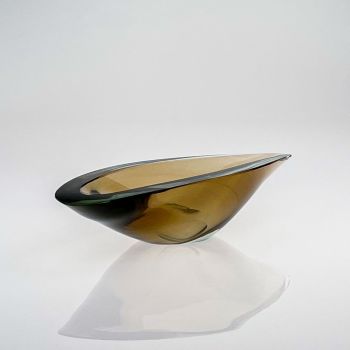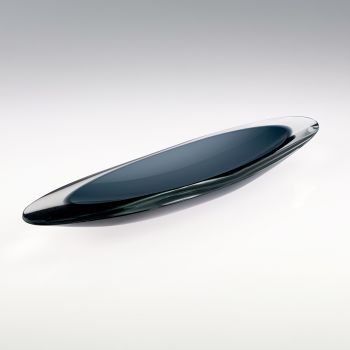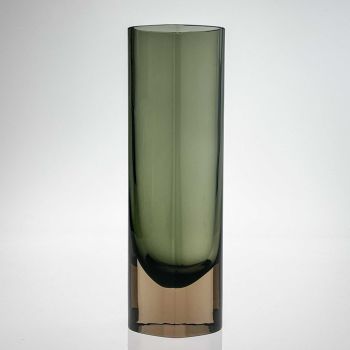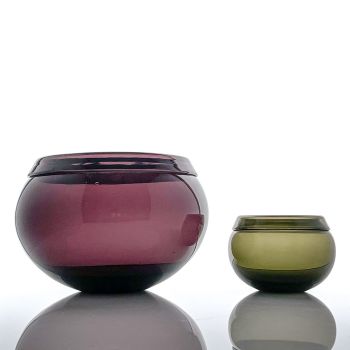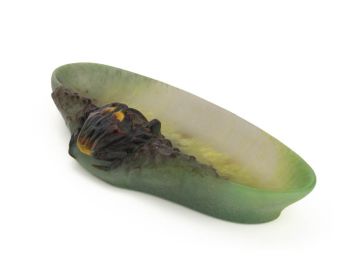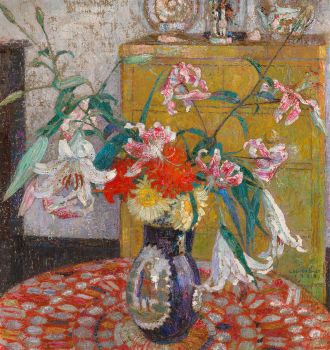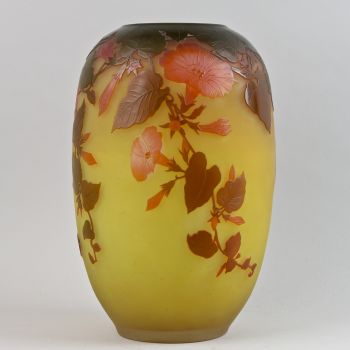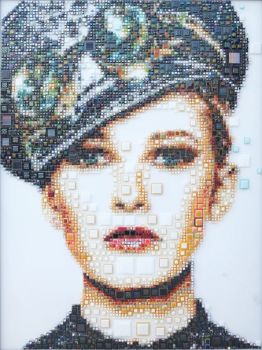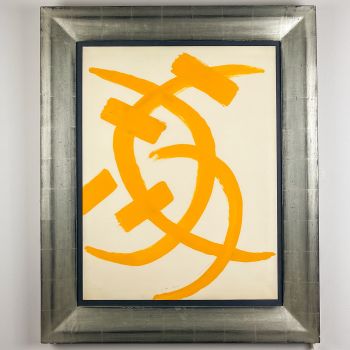Glass Art-object “Prisma”, model KF 215 in brown and grey hues – Nuutajärvi-Notsjö, Finland 1962 1962
Kaj Franck
Glas
13 ⨯ 9 ⨯ 7 cm
ConditionVery good
€ 750
Van Kerkhoff Art
- Over kunstwerkA free blown, cased glass, facet cut Art-object “Prisma”, model KF 215, in brown and grey hues. Designed by Kaj Franck in 1953 and executed by the Nuutajärvi-Notsjö glassworks, Finland in 1962.
These rare vases were made between 1954 and 1968 in four different sizes ranges, this example falls within the second smallest size range. It is fully marked and dated underneath the base in diamondpen: K. Franck Nuutajärvi-Notsjö ’62 (1962).
About Kaj Franck
Kaj Franck (Vyborg, Finland 1911 – Santorini, Greece 1989), a pioneering Finnish designer and a prominent figure in the Finnish art world from 1940 to 1980, left an indelible mark on the design landscape. Today, his name is synonymous with excellence and innovation, as exemplified by the prestigious “The Kaj Franck Design Prize,” which is annually awarded by the esteemed Finnish Design Forum.
Born in 1911 on the Finnish-Russian border into a family with a rich architectural heritage, Franck had design in his blood. His grandfather held a prominent position as the director of the renowned Arabia Ceramics factory, underscoring the influence and inspiration that surrounded him from an early age.
Franck pursued his passion for design by studying at the furniture department of Taideteollinen korkeakoulu, known today as the Aalto University School of Arts, Design, and Architecture, in Helsinki. Equipped with a solid foundation in design principles, he embarked on a career as a freelance designer before joining Arabia in 1945. It was during his time at Arabia that Franck’s talent truly flourished, and in 1950, he assumed the role of the company’s Artistic Director.
While his contributions to Arabia were significant, Franck’s creative vision extended beyond ceramics. He also designed glass objects for Iittala between 1946 and 1950, and later for Nuutajärvi-Notsjö glassworks from 1950 to 1976. His designs, particularly in everyday tableware and glassware, propelled him to the forefront of the design world. Notably, his iconic Kilta tableware and Kartio glassware are celebrated as revolutionary and enduring symbols of classic Finnish design.
Franck’s design philosophy embodied a profound commitment to principles of moderation, ecology, and equality. Often referred to as “the conscience of Finnish design,” he advocated for minimalism and the conscious reduction of everyday objects, emphasizing the importance of sustainability and product life cycles. Franck’s designs were a testament to his belief that beauty and functionality could coexist harmoniously, enhancing the lives of individuals while respecting the environment.
Recognized for his exceptional contributions, Franck’s works grace the collections of esteemed museums worldwide. Noteworthy institutions such as the Design Museum Helsinki, the Museum of Modern Art in New York, the Stedelijk Museum Amsterdam, and The British Museum in London all proudly display his creations. Throughout his illustrious career, Franck received numerous accolades, including the prestigious Lunning Prize in 1955, as well as “Grand Prix” and multiple “Gold Medals” at the renowned Triennale di Milano.
Kaj Franck’s enduring legacy rests not only on his remarkable designs but also on his unwavering commitment to advancing the field of design. His vision, which emphasized sustainability, simplicity, and social consciousness, continues to inspire designers and enthusiasts alike, ensuring that his influence will be felt for generations to come.
Marked
Signed in diamondpen; K. Franck – Nuutajärvi-Notsjö – '62 (1962)
Execution
Nuutajärvi-Notsjö glassworks, Finland 1962
Condition
This Prisma is in good vintage condition. Some light scratches and wear consistent with age and use. No further chips or cracks.
Literature
Marianne Aav (ed.), Kaj Franck, Universal Forms, p.222, p.323
Dimensions
Height 13 cm
Width 9 cm
Depth 6,5 cm
Weight 563 grams - Over kunstenaar
De Finse keramiek- en glasontwerper Kaj Franck (1911-1989) besefte een krachtige waarheid in zijn indrukwekkende carrière: eenvoudig is mooi. Ondanks dat de wereld zich in een steeds sneller tempo beweegt, van het ene decennium naar het andere, blijft die simpele waarheid bestaan. Franck's inspiratie en principes begonnen een traditie in Fins design, die nog steeds springlevend en sterk is. Zijn bekendste werken zijn de Iittala Teema- en Kartio-series, en zijn erfgoed maakt deel uit van elk Fins huis.
"Ik wil gebruik maken van objecten die zo voor de hand liggend zijn dat ze niet opvallen", definieerde Kaj Franck zijn eigen werk. Zijn ontwerpen kwamen tegemoet aan de basisbehoeften van de mens en dienden hen tegelijkertijd gereedschappen met eigenschappen van alledaagse voorwerpen. Franck was ook geïnteresseerd in lage- kostte massaproductie en schuwde materialisme, wegwerpcultuur en pronken. Francks wereld bestond uit wiskundige basisvormen en eenvoudige vormen, alleen versierd met sterke kleuren.
Uitgangspunt van het werk van Franck was bruikbaarheid gecombineerd met schoonheid. Hoewel het vandaag de dag vanzelfsprekend lijkt, waren zijn gedachten in zijn eigen tijd radicaal. Franck scheidde stijlen en modetrends van traditie en gaf er een geheel nieuwe betekenis aan. In de periode 1952-53 toonde Franck aan dat serviesgoed niet al te ingewikkeld hoeft te zijn met de release van de Kilta-serie als sterk statement - het was een nieuw idee dat iedereen de tafel kon dekken volgens zijn eigen behoeften .
Franck begon zijn ontwerpen door zich te concentreren op het idee of het onderliggende concept, niet op de vorm. Deze nadruk op het idee-aspect van design werd ook doorgevoerd in zijn werk als docent en later als artistiek directeur aan de Universiteit voor Kunst en Design in Helsinki. Franck was ook een van de eerste pleitbezorgers van recycling, en hij wordt vaak het "geweten van Fins design" genoemd. Franck won vele prijzen in zijn indrukwekkende carrière en werd internationaal beroemd. Tegenwoordig is de Kaj Franck Award de meest prestigieuze designonderscheiding van Finland .
Bent u geïnteresseerd om dit kunstwerk te kopen?
Artwork details
Related artworks
- 1 - 4 / 9
Børge Mogensen
Teak wood “dropleaf” desk – Søborg Møbler, Denmark circa 19551950 - 1960
Prijs op aanvraagVan Kerkhoff Art
1 - 4 / 24Johann Loetz (Lötz) Witwe Klostermühle
Johann Loetz Witwe - Phänomen Genre 7773 – Orange1900 - 1910
Prijs op aanvraagAntiques Emporium
Amalric Walter
Amalric Walter & Henri Bergé – Crabe plumier1920 - 1929
Prijs op aanvraagAntiques Emporium
Gabriel Argy-Rousseau
Gabriël Argy-Rousseau – Crabes et Algues vase – 19201920 - 1929
Prijs op aanvraagAntiques Emporium
Johann Loetz (Lötz) Witwe Klostermühle
Johann Loetz Witwe – Ausfuehrung 146 Titania vase – 19121910 - 1919
Prijs op aanvraagAntiques Emporium
1 - 4 / 24Onbekende Kunstenaar
A Japanese bronze Hu flower vase, Edo / Meiji, 19th century19th century
Prijs op aanvraagMenken Works of Art
Johann Loetz (Lötz) Witwe Klostermühle
Johann Loetz Witwe – Jugendstil Cobalt Papillon vaas1900 - 1910
Prijs op aanvraagAntiques Emporium
Johann Loetz (Lötz) Witwe Klostermühle
Johann Loetz Witwe – Ausfuehrung 146 Titania vase – 19121910 - 1919
Prijs op aanvraagAntiques Emporium
Onbekende Kunstenaar
François-Théodore Legras – Tall “Fleurs de Pommier” apple blossoms vase1900 - 1909
Prijs op aanvraagAntiques Emporium
1 - 4 / 24Onbekende Kunstenaar
Cristallo façon de Venise Drinkglas1600 - 1650
Prijs op aanvraagPeter Korf de Gidts - Antiquairs
Frères Daum
Daum Nancy – “Paysage Soleil Couchant” vase with two applied handles1900 - 1910
Prijs op aanvraagAntiques Emporium
Johann Loetz (Lötz) Witwe Klostermühle
Johann Loetz Witwe – Ausfuehrung 146 Titania vase – 19121910 - 1919
Prijs op aanvraagAntiques Emporium
1 - 4 / 24- 1 - 4 / 12









